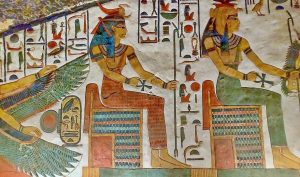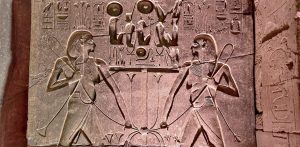The eye of Ra is frequently confused with the eye of Horus, as both are originally the two eyes of Horus! Thus, there are two identical eye symbols in ancient Egypt. The Eye of Ra serves as the solar deity of Ra’s feminine counterpart as well as a powerful force that subdues his foes. The Eye of Horus was viewed as a protecting spirit with healing qualities, but Ra had distinct characteristics.

The Eye of Ra is a Goddess.
The eye is an extension of Ra’s might, associated with the disc of the sun, yet it frequently acts as a separate deity. This goddess is associated with a number of goddesses, including Hathor, Sekhmet, Bastet, Raet-Tawy, and Mut. The eye, or Ra goddess, serves as the sun god’s mother, sibling, companion, and daughter.

The power of this eye protects Ra and his son (The Pharaoh) against the agents of chaos that threaten his reign. The Eye goddess’s might is frequently portrayed by a lioness or the uraeus, or snake, a sign of protection and royal authority.
Protective and aggressive Eye.
The cobra snake on the pharaoh’s forehead is a wonderful emblem of the Eye of Ra as a protective goddess, and the lioness heads on the pharaoh’s throne are an aggressive image for defending the god’s son (the Pharaoh).

The Eye of Ra can also be used to protect common people. On one side of several apotropaic amulets in the shape of the Eye of Horus is a deity. These amulets are most likely a reference to the Eye of Horus and the Eye of Ra’s relationship, evoking their power for personal protection. In addition, several New Kingdom magical spells call for the installation of clay model uraei around a home or a chamber, as in temple rites, to invoke the protection of the sun uraeus. These uraei are meant to ward off bad spirits and the nightmares they are said to produce, as well as other adversaries of the occupants of the dwelling. The models had “fire in their jaws,” according to the spell. Models similar to those in the spells have been discovered in the ruins of ancient Egyptian villages, and they contain basins in front of their mouths where fuel may be burned, however, no evidence of this has been found. The fire in the cobras’ mouths, like the flames spewed by the Eye of Ra, was designed to dispel the nightly darkness and destroy the hazardous entities that moved inside it, whether literally or metaphorically.
Eye of Ra in the Mythology

- The Egyptian sun deity Ra was thought to sail across the sky on his boat during the day and take it back to the underworld at night.
- According to legend, the human Ra was old and frail, and because of this, his people began to disregard his rules and directives. To punish his people, he sent his daughter, Ra’s lion’s eye. The eye grew enraged and annihilated humanity. The gods were worried that the eye would kill everyone. Ra got his eyes intoxicated on red beer and passed out. The eye then calmed down and returned to Ra.
- Another legend claims that he has Ra’s eye, which he uses to gather information. This function is often combined with the previous one, and he executes justice using the information gathered by his eye.
- When Ra acts as a loving parent and sends his eye to look for his two missing children, the eye serves a more benign role.
- The emblem of a snake wrapped around a solar disc is another portrayal of Ra’s eye. However, there is a flaw in this emblem, in that it is also used to symbolize another deity. She also has a connection to the eye, which is her emblem.
The Difference between the Eye of Ra and the Eye of Horus
The eye of Ra is frequently mistaken for the eye of Horus. The two, however, are not the same. The right eye is represented by Ra’s eye, while the left eye is represented by Horus’ eye. Ra is the solar god, and his might is comparable to that of the monotheistic faiths’ almighty gods. In this sense, his eyesight is limitless, and his eye is known as “the eye that sees everything.” Horus, on the other hand, has limited powers and relies heavily on physical integrity for defense.

The distinction is that Ra’s eye is depicted as a right eye, whilst Horus’ eye is depicted as a left eye. The Egyptians have employed the eye of Horus as a powerful protective sign for thousands of years. It is linked to vision (particularly the power of seeing between the worlds of the living and the dead), as well as the preservation of bodily integrity and health. It protects the person when worn as an amulet around the neck.
It’s worth noting that the Eye of Horus emblem correlates to the sixth chakra’s representation of the Third Eye. The sixth chakra is associated with intuition and clairvoyance (the capacity to “see” things that are otherwise hidden).

The eye of Horus, a thousand-year-old amulet utilized since antiquity, has been able to travel across the years to protect mankind. Wear it as a piece of jewelry to get the benefits of its health-promoting properties. Its integrity will be protected if it is shown in a home. Remember that the eye of Horus is symbolized by a left eye, whereas the eye of Ra is symbolized by a right eye. It is a strongly protective emblem.






